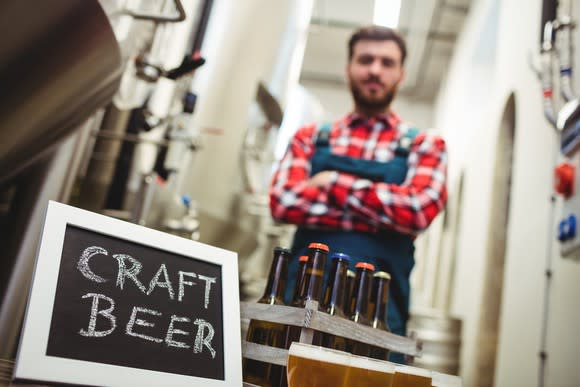Maybe Craft Beer's Outlook Isn't as Gloomy as Big Beer Thinks
Maybe we should hold off on the death dirge for craft beer just a little while longer. Although Beer Institute data suggests the industry is growing only because of the proliferation of taprooms and brew pubs -- on-premise locations where breweries sell their beer -- that might not be the whole picture.
According to the Brewers Association, which represents the craft beer industry, while the at-the-brewery channel did enjoy substantial growth last year, distributed channels (or shipping beer to retail locations) were also up, just not as much as at the taprooms.

Image source: Getty Images.
A survey of over 3,000 craft brewers, combined with state sales tax data, showed that in absolute terms small and independent brewers saw distributed sales grow by around 800,000 barrels last year, compared to a 400,000-barrel increase in direct sales. Percentage-wise the latter may have been larger, but it indicates the craft beer industry is still finding a lot of beer drinkers picking up their suds at the packaged goods store.
The trade group's data seems to be backed up by independent market analysts, too. Researchers at IRI Group found off-premise volumes at multi-outlet locations and convenience stores rose 3.8% last year while Nielsen data saw only a 0.7% rise in on-premise sales. While these analysts have a slightly wider definition than the Brewers Association for what constitutes a craft beer -- they're likely to include niche beers from megabrewers Anheuser-Busch InBev and Molson Coors like Shock Top and Blue Moon -- it's clear sales are still growing beyond the taprooms and brewpubs.
Still bellying up to the bar
Beer isn't going away anytime soon, and at over $111 billion in 2017, it still represents massive spending by consumers and is more than they spent on wine and spirits combined. In comparison, Americans spent $41.8 billion on wine last year and $26.2 billion on spirits.
But consumers have shown a propensity to spend more on the latter categories than on beer in recent years, and wine and spirits are taking market share in the process, though it's coming more from the largest brewers, especially in craft.
Boston Beer (NYSE: SAM), the second-largest craft brewer, continues to have a hard time moving its Samuel Adams beer, although it got a lift recently from higher sales of hard teas, cider, and seltzer in the first quarter. While its recently released Sam '76 lager-ale blend and a New England-style IPA seemed to be a hit with beer drinkers, it wasn't enough to offset the decline in its premier lager, which has not recorded a single instance of higher depletions in three years (depletions are an industry benchmark for consumer demand that measures sales to distributors and retailers).
Similarly, Anheuser-Busch saw its first-quarter U.S. beer volumes dragged lower, despite help from football's Super Bowl. While beer sales grew in Mexico, Colombia, and Argentina, overall volumes still decreased, dropping to 135 million hectoliters from 148 million hectoliters. Molson Coors saw a 6% drop in U.S. sales.
So although the beer industry as a whole is slowing, the true craft brewers -- the small, independent brewers -- are continuing to be supported by consumers closer to home, whether at taprooms and brewpubs, or the local convenience store.
The craft beer industry has been written off several times over the past few years as growth has slowed, but it's still showing an amazing resilience that belies larger trends. A eulogy for craft brewers may have to wait for another day.
More From The Motley Fool
Rich Duprey has no position in any of the stocks mentioned. The Motley Fool owns shares of and recommends Anheuser-Busch InBev NV and Boston Beer. The Motley Fool owns shares of Molson Coors Brewing. The Motley Fool has a disclosure policy.

 Yahoo Finance
Yahoo Finance 